| کد مقاله | کد نشریه | سال انتشار | مقاله انگلیسی | نسخه تمام متن |
|---|---|---|---|---|
| 2893809 | 1172421 | 2009 | 12 صفحه PDF | دانلود رایگان |

ObjectivePlasma free fatty acid (FFA) concentrations are increased in states of insulin resistance. Therefore, this study evaluated apoptosis and underlying mechanisms induced by selected nutritional FFAs, a defined FFA-mix, and human plasma containing high FFA concentrations in human smooth muscle cells (HSMCs).Research design and methodsHSMCs were incubated (24–72 h) with selected FFAs (100–300 μmol/l), an FFA-mix (palmitic-/stearic-/oleic-/linoleic-/α-linolenic acid = 2.6/1/3.6/9/1; 300–900 μmol/l), or with high FFA-plasma (600 μmol/l) versus respective control cultures. Apoptosis, caspase acitvation, and protein expression were determined by DNA-fragmentation assays, flow cytometry, and Western blots, respectively.ResultsExposure (24 h) of HSMCs to 300 μmol/l stearic-, oleic-, linoleic-, α-linolenic-, and arachidonic acid induced apoptosis, correlating (p < 0.01) with the FFAs’ chain length (r = 0.602) and number of FFA double bonds (r = 0.956). After 48 h, 100 μmol/l of all tested FFAs – including palmitic acid – were already sufficient to trigger HSMCs’ cell death. FFA-exposure resulted in activation of caspases and apoptosis was completely abolished by co-incubation with caspase inhibitors and negatively correlated (p < 0.01) with the base-excision repair protein XRCC1 (r = −0.765) and with c-myc's antagonist mad (r = −0.916), whereas positive correlations (p < 0.01) were found for protein expression of the proto-oncogene c-myc (r = 0.972) and the transcription factor E2F-1 (r = 0.971). Exposure of HSMCs to the defined FFA-mix and to plasma samples from individuals with elevated plasma FFAs supported the results obtained by defined FFA stimulation.ConclusionsSince smooth muscle cells surround the macrophage/foam cell/lipid-laden artheromatous core of atherosclerotic lesions with a protective fibrous cap, their FFA-induced HSMC apoptosis could contribute to progression of atherosclerosis by thinning of the fibrous cap and subsequent plaque destabilization.
Journal: Atherosclerosis - Volume 202, Issue 2, February 2009, Pages 351–362